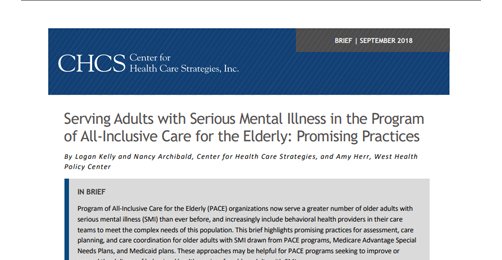Serving Adults with Serious Mental Illness in the Program of All-Inclusive Care for the Elderly: Promising Practices
Funder: West Health Policy Center
Author: Logan Kelly and Nancy Archibald, Center for Health Care Strategies, and Amy Herr, West Health Policy Center
September 2018 | Brief
The Program of All-Inclusive Care for the Elderly (PACE) provides medical care and long-term
services and supports (LTSS) to more than 45,000 adults age 55 and older in the United
States who meet a nursing facility level of care. Over 40 percent of PACE participants have
diagnoses that typically meet the criteria of serious mental illness (SMI), such as schizophrenia,
schizoaffective disorder, major depressive disorder, and bipolar affective disorder. The number of
PACE participants with SMI is growing as the overall population of older adults with SMI increases.
Additionally, many PACE organizations are enrolling a higher percentage of participants between the
ages of 55 and 64, and these participants have a higher rate of mental health diagnoses.
Approximately 90 percent of PACE participants are dually eligible for Medicare and Medicaid,
representing a population that has primarily received physical health, behavioral health, and longterm
services and supports (LTSS) via different programs and payment systems. Dually eligible
adults with physical and behavioral health conditions, as well as functional limitations, often
experience fragmented care with limited care coordination, which can result in poor quality of care
and high costs. Through a blended Medicare-Medicaid payment model, PACE organizations have
the potential to deliver integrated behavioral and physical health services, and LTSS to participants
with SMI.
Although PACE organizations are not required by the Centers for Medicare & Medicaid Services to
include mental health and psychiatric specialists on the interdisciplinary care team, a growing
number of these organizations are doing so to better meet the needs of participants with mental
illness or substance use disorders and reduce psychiatric institutional stays. Smaller PACE
organizations, however, may have fewer resources available to hire behavioral health clinicians.
When identifying how to deliver behavioral health care for participants with SMI, PACE organizations
need to develop strategies tailored to their size, participant health characteristics, and financial
considerations, while considering relationships with and availability of community mental health
providers.
PLEASE READ THE FULL BRIEF IN CENTER FOR HEALTH CARE STRATEGIES, INC.

